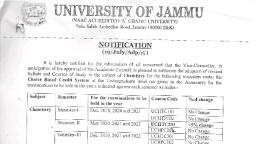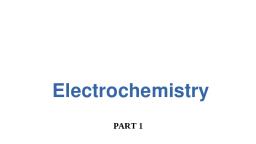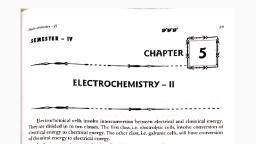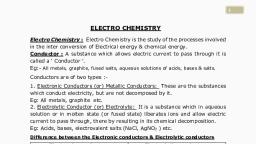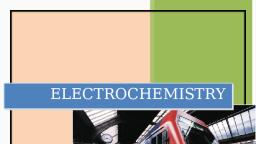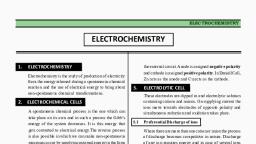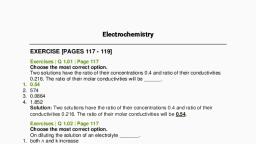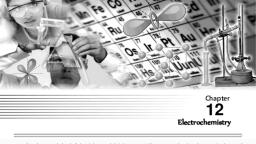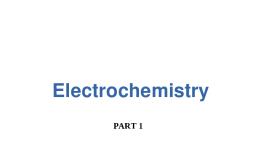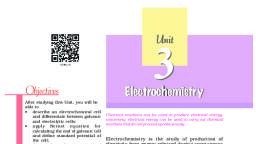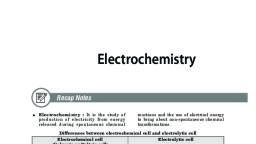Page 1 :
REVERSIBLE AND IRREVERSIBLE CELL, , Reversible Cell:, A cell is said to be reversivie if it satisfies the following three condittons :, , (i) Ifan opposing EMF equal to that of the cell is applied to the cell, no current should flow in the circuit, , and hence no chemical reaction should take place., , (ii) Ifan opposing EMF slightly (infinitesimally) smaller than that of the cell is applied, an infinitesimally, small current should flow from the cell and an infinitesimally small reaction should take place., , (iif) If an opposing EMF infinitesimaly greater than that of the cell is applied, an infinitesimally small, current should flow in the opposite direction and an infinitesimally small reaction in the reverse direction, , should occur., , , , , , AMMETER, = RHR, CELL OPPOSING E, Ep Ey E2, EMF = E, EMF = E,, E,=E, E,<Ey E,>€,, : ~ > FIGURE 4.9., Concept of reversible cell., , , , , , If the above conditions are not satisfied, the cell is said to be irreversible., , A well known example of a reversible cell is that of Daniell cell, consisting of a zinc electrode dipped in, ZaSO, solution and a copper electrode dipped in CuSO, solution, When it is producing current, the reaction, , taking place in the cell is :, , | Zn + Cu*+ —> Zn** + Cu, When an opposing EMF equal to that of the cell is applied, the reaction stops completely and no current, , flows at all. When an opposing EMF infinitesimally smaller than that of the cell is applied, an infinitesimally, | | small current flows from the cell and the above reaction is found to take place, If opposing EMF infinitesimally, | greater than that of the cell is applied, an infinitesimal current flows in the opposite direction and the above, | reaction is found to take place in the reverse direction,, , In the potentiometric methods for the determination of EMF, as no current flows at the time of measurement,, the conditions of reversibility is satisfied.
Page 2 :
Irreversible Cell-, Now, let us consider the example of a cell which is irreversible. Consider acell consisting of a zinc rod and, , a silver rod dipped in dilute sulphuric acid. When the two rods are connected with a wire, the following reaction, takes place :, , Zn +H,SO,—>» ZnSO, +H,, , Le., zinc is oxidized to Zn** ions and H?* ions are reduced to H) gas. In other words, zinc dissolves at one, electrode and H, gas is evolved at the other,, , Now, if the cell is connected to an external source of EMF (say a battery), whose EMF is slightly greater, than that of the cell and is opposing the cell, silver dissolves at one electrode and H, gas is evolved at the other
Page 3 :
ie., now oxidation takes place a fae ean ae,, cell can be ma de 10 satisfy the es ai silver electrode and reduction at the other. Thus, though the above, or king the opposing force ner condition of reversibility, i.¢., the direction of the current can be reversed by, sified, he, thetchem? simally greater than the driving force, the second condition of reversibility is, he 7" ane Bates change is not reversed (i.e., Zn + 2Ht —> Zn** + H, does not become, = 2 Pgh: . Instead, a new chemical reaction takes place. Hence the above cell is not reversible, put is irreve . Such cells, however, do not have any thermodynamic significance., , REVERSIBLE ELECTRODES, , ctrod i 4, , idea ee by Hers a are called reversible electrodes, Each electrode is termed as reversible, es jon occurring at the electrod i i irecti, , as in the reverse direction. ie je can take place in the direct direction as well, , The various reversible electrodes are classified into the following five different types., , ; 1. Metal-metal ion electrodes. Such an electrode consists of a metal dipped in the solution of its ions, ¢.g.,, zinc rod dipped in zinc sulphate solution, copper rod dipped in copper sulphate solution etc., , Taking the example of copper-copper ion electrode, when oxidation takes place at the electrode, the, reaction may be represented as, , , Cu—> Cu** +2 6°, On the other hand, when reduction takes place at the electrode, the reaction may be represented as :, Cu** +2e-—> Cu, , Thus, the electrode is reversible with respect to copper ions., , 2. Amalgam electrodes. These electrodes are just like metal-metal ion electrodes except that the metal is, replaced by its amalgam (i.e., solution of the metal in mercury). Forexample, zinc amalgam electrode consists of, zinc amalgam, dipping into a solution of zinc ions. The electrode is thus represented as Zn(Hg) | Za., , When oxidation takes place at the electrode, the electrode reaction is :, , Zn (Hg) —> Zn** +2 €, When reduction takes at the electrode, the reverse reaction is written, i-e.,, Zn* +2 e° —> Zn (Hg), , Thus, the electrode is reversible with respect to zinc ions., , Amalgam electrodes are preferred over metal-metal ions electrodes for the following reasons :, , (i) Equilibrium between the amalgam and the ions is established more quickly than with the pure metal., , (ii) Active metals like sodium, potassium, calcium etc, cannot be used directly as electrodes in aqueous, solutions. However, by changing them into amalgams, their activity is reduced and then they can be used., , (iii) The impurities present in metals (which sometimes cause erratic behaviour in pure metals) are diluted, , by amalgamation to give satisfactory results., 3. Gas electrodes. These electrodes consist of a gas bubbled around an inert metal wire or foil (usually of, , plantinized platinum) immersed in the solution capable of furnishing the ions of the gas. The function of the, metal wire or the foil is that firstly it helps to establish the equilibrium between the gas and its ions and secondly, , it helps to make an electrical contact, i.e., electrons Jost or gained can flow through it., , A few common gas electrodes are briefly described below :, (i) Hydrogen electrode. The design of the hydrogen electrode (which is, in fact, a general design for any, , gas electrode) is shown in Fig. 4.10., In the standard or normal hydrogen electrode, hydrogen gas at 1 atmospheric pressure is passed into 1M, , HClacid in which the foil of platinized platinum remains immersed.
Page 4 :
When in a cell, this electrode acts as the anode,, , i.e., oxidation takes place, the following reaction takes, Place ;, , , , , H,—> 2H* +267, Le., some hydrogen gas changes into H* ions, Which go into the solution., , When this electrode acts as cathode, i.e.,, reduction takes place, the following reaction occurs :, , <— 4 GAS AT, 1 ATM PRESSURE, , p— 1M HCI, , , , 2H* +2e°-—+H,, , , , i.e., some H* ions from the solution change into J-——PLATINUM FOIL COATED, , , , , , H, gas. Thus, the electrade is reversible with tespect of WITH PLBLACK, H? ions. This electrode is usually represented as “FIGURE 4.10., Pt, H; (g) | H* (cone. =) Hydrogen electrode., , , , (ii) Chlorine electrode. In this case, Cl, gas at a given pressure is passed into HCI acid which is capable, of furnishing the Cl” ions, For oxidatioin to take place, the following reaction occurs :, 2Cl-—> Cl, (g) +2e7, For reduction to occur, the following reaction take place : ,, Cl, +2 e°-—> 2C1Thus, the electrode is reversible with respect of Cl- ions., (iii) Oxygen electrode. This electrode is reversible with respect to hydroxy! ions. Thus, to construct this, , electrode, oxygen gas at a given pressure is passed into solution capable of giving OH™ ions. For reduction to, occur, the reaction taking place is, , O, (g)+2H,0 +2 e>—> 40HFor oxidation to occur, the reverse reaction takes place., 4. Metal-metal insoluble salt-salt anion electrodes. This is most commonly employed category of, , electrodes. Here the electrode consists of a metal in contact with its sparingly soluble salt and a solution of a, , soluble salt containing the same anion as that of the sparingly soluble salt. A few examples of the electrodes of, this type are :, , , , , , , , (i) Ag—AgCI—KCl electrode, prepared by dipping a silver fh, wire in KCI solution to which a drop of AgNO, is added (to form, AgCl)., , (ii) Ph—PbSO,—K7SO, electrode, prepared by dipping a Tie] | [BS em, lead wire in K,SO, solution to which a few drops of lead nitrate a, , solution are added (to form PbSO,)., , (iii) Hg—Hg,Cl,—KCl electrode (Calomel electrode). This, is the most frequently used electrode and is shown in Fig. 4.11. Itis, prepared as follows :, , Pure mercury is placed at the bottom of a tube T, Itis covered, with a paste of mercurous chloride (calomel) and then filled with, either decinormal or normat or saturated solution of KCI from the, side tube A such that the side tube B (ending into a jet) is also filled, with the KCI solution. A tube C having a piece of platinum wire, sealed at its end is fixed into the tube 7 such that the platinum wire, remains dipped into the mercury. A little mercury is placed in the |... FIGURE 4.11., tube C and a copper wire put into it to make an electrical contact. Calomel electrode., , , , , , , , Hg2Clz PASTE, Pt, WIRE
